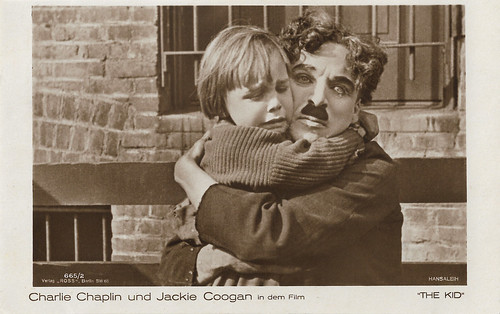
German postcard by Ross Verlag, no. 665/2. Photo: Hansaleih. Charlie Chaplin and Jackie Coogan in The Kid (Charles Chaplin, 1921).
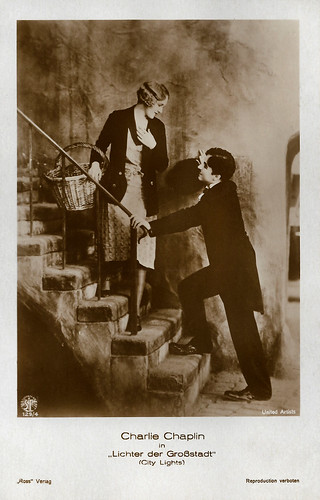
German postcard by Ross Verlag, no. 129/4. Photo: United Artists / SF. Charlie Chaplin and Virginia Cherrill in City Lights (Charles Chaplin, 1931).

Vintage postcard. Photo: Triangle.

British postcard in the H. B. Series., 'Entire British Production', London E.C., sent by mail on 30.7.1917. Signature: AEI.

French postcard by Editions Nugeron, no. 76.
Music Hall tradition
Charles Spencer Chaplin was born in 1889, in London, England. His parents were both entertainers in the Music Hall tradition; his father, Charles Spencer Chaplin Sr., was a vocalist and actor and his mother, Hannah Chaplin, was a singer and actress with the stage name Lilly Harley.
They separated before Charlie was three. Charlie lived with his mother and his older half-brother Sydney. Chaplin Sr. was an alcoholic and had little contact with his son, though Charlie and Sydney briefly lived with their father and his mistress, while their mentally ill mother lived at an asylum.
Hannah's first crisis came in 1894 when she was performing at The Canteen, a theatre in Aldershot, mainly frequented by rioters and soldiers. Hannah was injured by the objects the audience threw at her and she was booed off the stage. Backstage, she cried and argued with her manager.
Meanwhile, the five-year-old Chaplin went on stage alone and sang a well-known tune at that time, 'Jack Jones'. The young Chaplin brothers forged a close relationship in order to survive. They gravitated to the Music Hall while still very young, and both of them proved to have considerable natural stage talent. At eight Charlie toured in a musical, 'The Eight Lancaster Lads'. Nearly 11, he appeared in 'Giddy Ostende' at London's Hippodrome. Chaplin's early years of desperate poverty were a great influence on his film characters. His films would later re-visit the scenes of his childhood deprivation in Lambeth.
In 1901, his father died of cirrhosis of the liver when Charlie was twelve. His mother died in 1928 in Hollywood, seven years after having been brought to the US by her sons. Unknown to Charlie and Sydney until years later, they had a half-brother through their mother. The boy, Wheeler Dryden, was raised abroad by his father but later connected with the rest of the family and went to work for Chaplin at his Hollywood studio.

Vintage postcard. Photo: Chaplin Studios.

British postcard by Red Letter Photocard. Photo: Essanay.
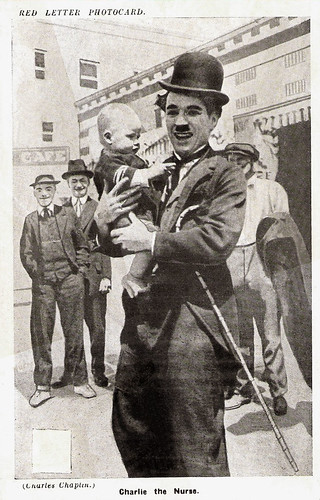
British postcard by Red Letter Photocard.

British postcard by Red Letter Photocard. Photo: Essanay. Publicity still for The Champion (Charles Chaplin, 1915) with Chaplin and Leo White.

British postcard by Red Letter Photocard, no. 4. Photo: Essanay.

British postcard by Red Letter Photocard, no.6. Photo: Essanay. Publicity still for Work (1915) with Edna Purviance.
Fred Karno's vaudeville troupe
From age 17 to 24, Charlie Chaplin joined Fred Karno's English vaudeville troupe. He first toured the United States with the Fred Karno troupe from 1910 to 1912. After five months back in England, he returned to the US for a second tour. In the troupe was also his brother Sydney and Arthur Stanley Jefferson, who later became known as Stan Laurel.
In late 1913, Chaplin's act with the Karno troupe was seen by Mack Sennett, Mabel Normand, Minta Durfee, and Fatty Arbuckle. Sennett hired him for his studio, the Keystone Film Company as a replacement for Ford Sterling.
Chaplin had considerable initial difficulty adjusting to the demands of film acting and his performance suffered for it. After Chaplin's first film appearance, Making a Living (Henry Lehrman, 1914) was filmed, Sennett felt he had made a costly mistake. Mabel Normand persuaded Sennett to give Chaplin another chance, and she directed and wrote a handful of his earliest films.
He first played The Tramp in the Keystone comedy Kid Auto Races at Venice (Henry Lehrman, 1914). This picture saw him wearing baggy pants borrowed from Roscoe 'Fatty' Arbuckle, size 14 shoes belonging to Ford Sterling (and worn upside down to keep them from falling off), a tiny jacket from Keystone Kop Charles Avery, a bowler hat belonging to Arbuckle's father-in-law and some crepe paper belonging to Mack Swain (which became the tramp's moustache). The only item that actually belonged to Charlie was the cane.
Two films Chaplin made in 1915, The Tramp and The Bank, created the characteristics of his screen persona. Chaplin was influenced by his predecessor, the French silent film comedian Max Linder, to whom he dedicated one of his films. Quickly the little tramp became the most popular Keystone star.
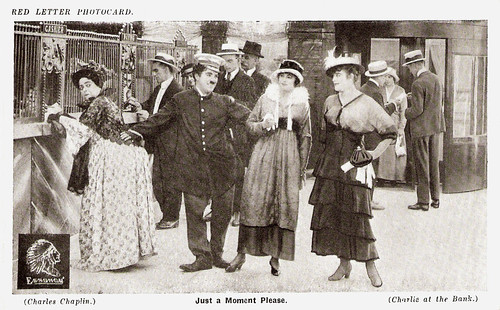
British postcard by Red Letter Photocard. Photo: Essanay. Publicity still for The Bank (1915).

British postcard by Red Letter Photocard. Photo: Essanay. Publicity still for The Tramp (1915).

British postcard by Red Letter Photocard. Photo: Essanay. Publicity still for The Tramp (1915). Chaplin as the Tramp, Ernest Van Pelt as the Farmer and Paddy McGuire as the Farmhand.
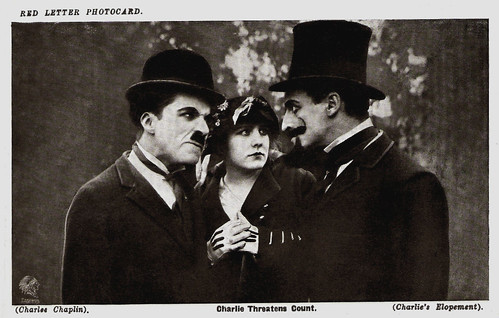
British postcard by Red Letter Photocard. Photo: Essanay. Publicity still for A Jitney Elopement (1915) with Charles Chaplin, Edna Purviance and Leo White.
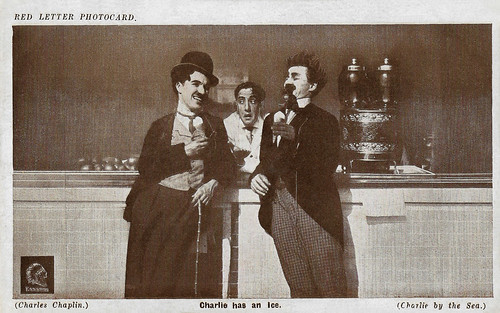
British postcard by Red Letter Photocard. Photo: Essanay. Chaplin and Billy Armstrong enjoy an ice cream after their fight in By the Sea (1915). The ice cream clerk is 'Snub' Pollard.

British postcard by Red Letter Photocard. Photo: Essanay. Chaplin and Margie Reiger flirt in By the Sea (1915), while Bud Jamison and Billy Armstrong are not too happy about this, and Edna Purviance fears trouble is coming up. The film was shot at Crystal Pear in Los Angeles.
Keystone, Essanay, Mutual, First National, United Artists
From the April 1914 one-reeler Twenty Minutes of Love (Charles Chaplin, Joseph Maddern, 1914) onwards, Charles Chaplin wrote and directed most of his films himself. By 1916 he was producing them, and from 1918 he was also composing the music.
He made 35 films in 1914, moved to Essanay in 1915 and did 14 more, then jumped over to Mutual for 12 two-reelers in 1916 and 1917. In 1918 he joined First National (later absorbed by Warner Bros.) and in 1919 formed United Artists along with Douglas Fairbanks, Mary Pickford and D.W. Griffith.
His first full-length film was The Kid (1921) with Jackie Coogan; his first film for United Artists, which he produced and directed himself, was A Woman of Paris: A Drama of Fate (1923) starring Edna Purviance. Chaplin continued to play The Tramp through dozens of short films and, later, feature-length productions. In only a handful of films, he played different characters.
The Tramp was closely identified with the silent era, and was considered an international character; when the sound era began in the late 1920s, Chaplin refused to make a talkie featuring the character. City Lights (1931) featured no dialogue. Chaplin officially retired the character in Modern Times (1936), which appropriately ended with the Tramp and his girl (played by Chaplin’s third wife, Paulette Goddard) walking down an endless highway towards the horizon. The film was only a partial talkie and is often called the last silent film.
The Tramp remains silent until near the end of the film when, for the first time, his voice is finally heard, albeit only as part of a French/Italian-derived gibberish song. This allowed The Tramp to finally be given a voice but not tarnish his association with the silent era.

German postcard by Ross Verlag, Berlin, no. 581/4,1919-1924. Photo: B.B.B. Collection: Didier Hanson.

German postcard by Ross Verlag, no. 581/5, 1919-1924. Photo: B.B.B. Collection: Didier Hanson.

German postcard by Ross Verlag, Berlin, no. 1843/1, 1927-1928. Collection: Didier Hanson.

German postcard by Ross Verlag, Berlin, no. 90/3, 1925-1935. Photo: United Artists. Publicity still for The Circus (1928). Collection: Didier Hanson.

German postcard by Ross Verlag, Berlin, no. 987/1, 1925-1926. Collection: Didier Hanson.

French postcard by Editions Cinematographiques, no. 499. Photo: United Artists. Publicity still for The Circus (1928). Collection: Didier Hanson.
Adulation and controversy
Charlie Chaplin’s high-profile public and private life encompassed both adulation and controversy. Chaplin's political ideas ultimately forced him to resettle in Europe during the McCarthy era in the early 1950s. Chaplin's political sympathies always had laid with the left. His silent films made prior to the Great Depression typically did not contain overt political themes or messages, apart from The Tramp's plight in poverty and his run-ins with the law, but his 1930s films were more openly political. Modern Times (1936) depicts workers and poor people in dismal conditions.
In The Great Dictator (1940) Chaplin plays a humorous caricature of Adolf Hitler. Some thought the film was poorly done and in bad taste. However, it grossed over $5 million and earned five Academy Award Nominations. The final dramatic speech in The Great Dictator, which was critical of following patriotic nationalism without question, and his vocal public support for the opening of a second European front in 1942 to assist the Soviet Union in World War II were controversial. Chaplin declined to support the war effort as he had done for the First World War which led to public anger, although his two sons saw service in the army in Europe.
For most of World War II, he was fighting serious criminal and civil charges related to his involvement with 22-year-old actress Joan Barry. In 1943 he was accused of fathering her child; the papers made much of the scandal, but it was proved in a court trial that he was not the father. The same year he entered his fourth marriage, to Oona O'Neill, daughter of playwright Eugene O'Neill.
After the war, his black comedy, Monsieur Verdoux (1947) showed a critical view of capitalism. Chaplin's final American film, Limelight, was less political and more autobiographical in nature. Limelight also featured Claire Bloom and Chaplin’s longtime friend, Buster Keaton.
In 1952, Chaplin left the US for what was intended as a brief trip home to the United Kingdom for the London premiere of Limelight. J. Edgar Hoover, head of the FBI, learned of the trip and negotiated with the Immigration and Naturalization Service to revoke Chaplin's re-entry permit, exiling Chaplin so he could not return for his alleged political leanings.
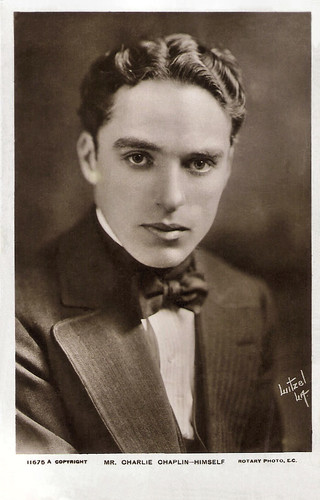
British postcard by Rotary, no 11675 A. Photo: Witzel.

Spanish postcard by Editorial Photográfica, Barcelona, no. A - 103.

German postcard by Ross Verlag, Berlin, no. 1163/3, 1927-1928. Photo: Ifa / United Artists.
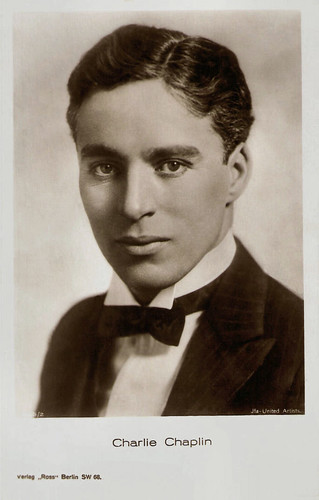
German postcard by Ross Verlag, Berlin, no. 1165/2, 1927-1928. Photo: Ifa / United Artists.

A fashionable Chaplin on a French postcard from the 1920s.

British postcard in the Film Weekly Series, London.
A King in Switzerland
Charles Chaplin made his home in Vevey, Switzerland. His final two films were made in London. A King in New York (1957),(in) which he starred, wrote, directed and produced, satirised the political persecution and paranoia that had forced him to leave the US five years earlier.
His last film, A Countess from Hong Kong (1967), which he directed, produced, and wrote, starred Sophia Loren and Marlon Brando. Chaplin made his final on-screen appearance in a brief cameo role as a seasick steward. He also composed the music for both films. The theme song from A Countess From Hong Kong, 'This is My Song', reached number one in the UK as sung by Petula Clark.
Chaplin also compiled a film The Chaplin Revue (1959) from three First National films A Dog's Life (1918), Shoulder Arms (1918) and The Pilgrim (1923) for which he composed the music and recorded an introductory narration. As well as directing these final films, Chaplin also wrote 'My Autobiography', which was published in 1964. He briefly and triumphantly returned to the United States in April 1972, with his wife Oona, to receive an Honorary Oscar, and also to discuss how his films would be re-released and marketed.
Chaplin's last completed work was the score for his film A Woman of Paris (1923), which was completed in 1976, by which time Chaplin was extremely frail, even finding communication difficult. Charles Chaplin died in his sleep in Vevey on Christmas Day 1977. He and Oona had eight children, including film actress Geraldine Chaplin. From his four marriages, he had a total of 11 children.
In 1921 Chaplin was decorated by the French government for his outstanding work as a filmmaker and was elevated to the rank of Officer of the Legion of Honor in 1952. In 1929, at the first Oscar Awards, he won a special award "for versatility and genius in writing, acting, directing and producing" The Circus (1928). In 1975 he was named Knight Commander of the British Empire. His bowler and cane were sold for $150,000 in 1987. In 1999, the American Film Institute ranked Chaplin the 10th Greatest Actor on The 50 Greatest Screen Legends list. Author George Bernard Shaw once called Chaplin "the only genius to come out of the movie industry".
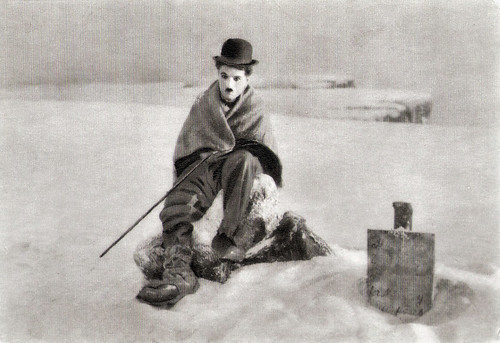
French postcard by Hélio-Cachan. Photo: publicity still for The Gold Rush (Charles Chaplin, 1925).

French postcard by Hélio-Cachan. Photo: publicity still for The Gold Rush (Charles Chaplin, 1925).

Dutch postcard. Sent by mail in the Netherlands in 1948. Photo: publicity still for The Great Dictator (Charles Chaplin, 1940).

East-German collectors card, no. III/18/211, 1955. Photo: United Artists. Publicity still for Limelight (Charles Chaplin, 1952).

French postcard by Editions P.I., presented by Les Carbones Korès Carboplane, no. 568 Photo: United Artists.

French postcard in the Entr'acte series by Éditions Asphodèle, Mâcon, no. 005/4. Photo: Collection B. Courtel / D.R. Charles Chaplin and Geraldine Chaplin on the set of The Countess from Hong Kong (Charles Chaplin, 1966). Caption: Charles Chaplin, whose last film this was, directed his daughter Geraldine.
Sources: Ed Stephan (IMDb), Amy Smith (IMDb), Linda Wada (Edna's Place), Wikipedia and IMDb.
This post was last updated on 16 September 2023.
Extraordinary photos of the great Chaplin. I devoured Lita Grey's memoir as a teenager (she was 16 when they married).
ReplyDelete